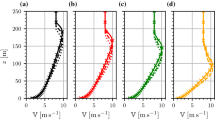Abstract
The atmospheric circulation spans a wide range of spatial scales, including the planetary scale (~10,000 km), synoptic scale (~2,000 km), mesoscale (~200 km), and convective scales (< 20 km). The wide scale separation between convective motions, responsible for the vertical energy transport, and the planetary circulation, responsible for the meridional energy transport, has prevented explicit representation of convective motions in global atmospheric models. Kuang et al. (Geophys. Res. Lett. 32: L02809, 2005) have suggested a way to circumvent this limitation through a rescaling that they refer to as Diabatic Acceleration and REscaling (DARE). We focus here on a modified version of the procedure that we refer to as hypohydrostatic rescaling. These two strategies are equivalent for inviscid and adiabatic flow in the traditional meteorological setting in which the vertical component of the Coriolis acceleration is ignored, but they differ when atmospheric physics is taken into account. It is argued here that, while the hypohydrostatic rescaling preserves the dynamics of the planetary scale circulation, it increases the horizontal scale of convective motions. This drastically reduces the computational cost for explicit simulation of hypohydrostatic convection in a global atmospheric model. A key question is whether explicit simulations of hypohydrostatic convection could offer a valid alternative to convective parameterization in global models. To do so, radiative–convective equilibrium is simulated with a high-resolution non-hydrostatic model using different model resolutions and values of the rescaling parameter. When the behavior of hypohydrostatic convection is compared with coarse-resolution simulations of convection, the latter set of simulations reproduce more accurately the result from a reference high-resolution simulation. This is particularly true for the convective velocity and cloud ice distributions. Scaling arguments show that hypohydrostatic rescaling increases the convective overturning time. In particular, this convective slowdown associated with the hypohydrostatic rescaling is more significant than the slowdown resulting from under-resolving the convective elements. These results cast doubt on the practical value of the hypohydrostatic rescaling as an alternative to convective parameterization.
Similar content being viewed by others
References
Anderson J.L., Balaji V., Broccoli A.J., Cooke W.F., Delworth T.L., Dixon K.W., Donner L.J., Dunne K.A., Freidenreich S.M., Garner S.T., Gudgel R.G., Gordon C.T., Held I.M., Hemler R.S., Horowitz L.W., Klein S.A., Knutson T.R., Kushner P.J., Langenhorst A.R., Lau N.-C., Liang Z., Malyshev S.L., Milly P.C.D., Nath M.J., Ploshay J.J., Ramaswamy V., Schwarzkopf M.D., Shevliakova E., Sirutis J.J., Soden B.J., Stern W.F., Thompson L.A., Wilson R.J., Wittenberg A.T., Wyman B.L. (2004): The new GFDL global atmosphere and land model AM2/LM2: evaluation with prescribed SST simulations. J. Atmos. Sci 17, 4641–4673
Colella P., Woodward P.R. (1984): The piecewise parabolic method (PPM) for gas-dynamical simulations. J. Comput. Phys. 54, 174–201
Davies-Jones R. (2003): An expression for effective buoyancy in surroundings with horizontal density gradients. J. Atmos. Sci. 60, 2922–2925
Freidenreich, S.M., Ramaswamy, V.: A new multiple-band solar radiative parameterization for general circulation models. J. Geophys. Res. 104, 31, 389–31, 409 (1999)
Garner, S.G., Frierson, D., Held, I., Pauluis, O., Vallis, G.: Resolving convection in a global hypohydrostatic model. J. Atmos. Sci (2006) (submitted)
Grabowski W., Wu X., Moncrieff M.W. (1996): Cloud-resolving modeling of tropical cloud systems during phase III of GATE. Part I: Two-dimensional experiments. J. Atmos. Sci. 53, 3684–3709
Grabowski W., Yano J.-I., Moncrieff M.W. (2000): Cloud resolving modeling of tropical circulations driven by large-scale SST gradients. J. Atmos. Sci. 57, 2022–2040
Held I.M., Hemler R.S., Ramaswamy V. (1993): Radiative-convective equilibrium with explicit two-dimensional moist convection. J. Atmos. Sci. 50, 3909–3927
Klemp J.B., Wilhelmson R.B. (1978): The simulation of three-dimensional convective storm dynamics. J. Atmos. Sci. 35, 1070–1096
Krueger S.K., Fu Q., Liou K.N., Schin H.-N. (1995): Improvements of an ice-phase microphysics parameterization for use in numerical simulations of tropical convection. J. Appl. Meteorol. 34, 281–287
Kuang Z., Blossey P.N., Bretherton C.S. (2005): A new approach for 3D cloud resolving simulations of large scale atmospheric circulation. Geophys. Res. Lett. 32: L02809
Lin Y.-L., Farley R.D., Orville H.D. (1983): Bulk parameterization of the snow field in a cloud model. J. Appl. Meteorol. 22, 1065–1092
Lipps F.B., Hemler R.S. (2004): Scale analysis of deep, moist convection and some related numerical calculations. J. Atmos. Sci. 39, 2192–2210
Lord S.J., Willoughby H.E., Piotrowicz J.M. (1984): Role of a parameterized ice-phase microphysics in an axisymmetric, nonhydrostatic tropical cyclone model. J. Atmos. Sci. 41, 2836–2848
Pauluis O., Garner S. (2006): Sensitivity of radiative-convective equilibrium simulations to horizontal resolution. J. Atmos. Sci. 63, 1910–1923
Pedlosky J. (1979): Geophysical Fluid Dynamics. Springer, Berlin Heidelberg New York, p. 728,
Randall D., Krueger S., Bretherton C., Curry J., Duynkerke P., Moncrieff M., Ryan B., Starr D., Miller M., Rossow W., Tselioudis G., Wielicki B. (2003a): Confronting models with Data: the GEWEX cloud systems study. Bull. Am. Meteorol. Soc. 84, 455–469
Randall D.A., Khairoutdinov M., Arakawa A., Grabowski W. (2003b): Breaking the cloud parameterization deadlock. Bull. Am. Meteorol. Soc. 84, 1547–1564
Tomita H., Miura H., Iga S., Nasuno T., Satoh M. (2005): A global cloud-resolving simulation: preliminary results from an aqua planet experiment. Geophys. Res. Lett. 32:P L08805, DOI:10.1029/2005GL022459
Tompkins A, Craig G.C. (1998): Radiative-convective equilibrium in a three-dimensional cloud-ensemble model. Q. J. R. Meteorol. Soc. 124, 2073–2097
Xu K.-M., Randall D. (1996): Explicit simulation of cumulus ensembles with the GATE phase III data: comparison with observations. J. Atmos. Sci. 53, 3710–3736
Author information
Authors and Affiliations
Corresponding author
Additional information
Communicated by R. Klein
Rights and permissions
About this article
Cite this article
Pauluis, O., Frierson, D.M.W., Garner, S.T. et al. The hypohydrostatic rescaling and its impacts on modeling of atmospheric convection. Theor. Comput. Fluid Dyn. 20, 485–499 (2006). https://doi.org/10.1007/s00162-006-0026-x
Received:
Accepted:
Published:
Issue Date:
DOI: https://doi.org/10.1007/s00162-006-0026-x



